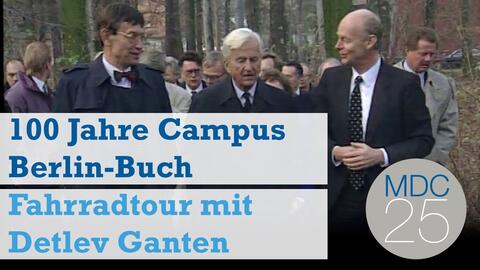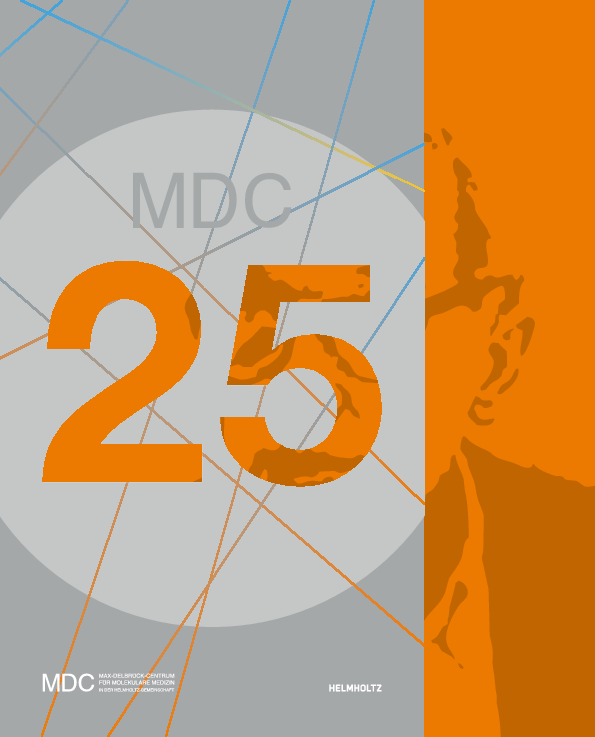
Our history
30 years of Max Delbrück Center and beyond

30 years of MDC
/30-jahre
For 30 years, scientists at the Max Delbrück Center have been investigating the underlying mechanisms of health and disease. This would not have been possible without thinking outside the box, say Thomas Sommer and Young-Ae Lee. We spoke with the two scientists about the history of the Max Delbrück Center and its approaches to biomedical research.
How it started
Between 1928 and 1930, the Kaiser Wilhelm Society established an Institute of Brain Research on what is now the present Berlin-Buch Campus. At that time, the institute was the largest and most modern of its kind in the world. In charge of the institute and its associated clinics was Oskar Vogt who, with his wife Cécile, were pioneers in modern brain research. Vogt managed to get the Russian geneticist, Nikolai Wladimirovich Timoféeff-Ressovsky involved in setting up a Department of Experimental Genetics at his institute. During the Nazi period, the brains from victims who had been killed as part of the Nazi euthanasia program were used for research purposes at the Kaiser Wilhelm Institute of Brain Research. There is remembered with a memorial on our campus.
When you do science, you potentially change the world much more than Caesar or any of the great military or political figures ever did, and you can sit very quietly in a corner and do that.
In 1947, the German Academy of Sciences in Berlin set up the Institute of Medicine and Biology in the former Institute of the Kaiser Wilhelm Society. This grew into an internationally celebrated center for cancer and cardiovascular research in which basic and clinical research were closely integrated. In 1972, the Institutes of the GDR Academy of Sciences, which had been established after 1947 from the Institute of Medicine and Biology, were formed into three central institutes: cancer research, cardiovascular research and molecular biology. After the reunification of East and West Germany, these three institutes became the Max Delbrück Center in 1992. The two research clinics that had belonged to the central institutes became incorporated into the Charité of the Humboldt University of Berlin.
The Max Delbrück Center is named after the German-American Nobel Prize winner Max Delbrück. Together with Timoféeff-Ressovsky, who worked in Buch from 1930 to 1945, Delbrück laid the foundations of molecular genetics. Their joint publication with Karl Günter Zimmer in 1935, entitled "Über die Natur der Genmutation und der Genstruktur" (On the nature of gene mutation and gene structure) made a pioneering contribution in this area. Others working in Berlin at that time included the radiation researcher Walter Friedrich, the discoverer of the cellular energy transporter ATP, Karl Lohmann, the cancer researchers Arnold Graffi and Hans Gummel, the biochemist Erwin Negelein, and the cardiologist Albert Wollenberger.
100 years of the Berlin-Buch Campus
Berlin-Buch has a long tradition as a medical research location: As early as the beginning of the 20th century, an important medical center with several clinics was established here, which at times comprised more than 5,000 beds.

Biographies
- Max Delbrück
- 4/9/1906 Berlin - 10/3/1981 Pasadena/USA
Berlin-born physicist: He co-authored in 1935 with Nikolai Wladimirovich Timoféeff-Ressovsky and Karl Günter Zimmer the landmark paper "On the nature of gene mutation and gene structure". In 1969, he was awarded the Nobel Prize for Physiology and Medicine jointly with Alfred Hershey and Salvadore Luria for discoveries involving the replication mechanisms and genetic structure of viruses. His fundamental work on genetic mechanisms and bacteriophages make Delbrück one of the founding fathers of modern genetics.
- Walter Friedrich
- 25/12/1883 Magdeburg - 6/10/1968 Berlin
Biophysicist: In 1922, he founded a chair of Medical Physics at Berlin University. He was head of the Institute of Medicine and Biology of the Academy of Sciences in Berlin-Buch, which was founded in 1947. Together with Max von Laue and Paul Knipping, he produced evidence for the electromagnetic nature of X-rays and his research formed the basis of radium therapy.
- Arnold Graffi
- 19/6/1910 Bistritz (Siebenbürgen / Rumania) - 30/1/2006 Berlin
Cancer researcher: From 1948 to 1975, departmental head at the Institute of Medicine and Biology in Berlin-Buch and then, later, Director of the Institute of Experimental Cancer Research. Graffi was particularly closely involved in the carcinogenic effects of chemicals as well as how viruses trigger cancer. One of the cancer-provoking viruses he discovered is now referred to in the scientific literature as the Graffi virus. As one of the first molecular biologists, in 1960 he formulated the concept of treatment using "Nucleic acid antimatrices," which was the forerunner of a current approach used in gene therapy. In 1995, he was awarded the highest level of the Order of Merit of the Federal Republic of Germany.
- Hans Gummel
- 3/8/1908 Berlin - 27/5/1973 Berlin
From 1949, cancer surgeon at the Tumor Clinic of the Academy of Sciences in Berlin-Buch, later to become the Robert Rössle Clinic; from 1954 to 1973, he was Medical Director of the Clinic. He was principally involved in extending the Rössle Clinic, advancing the discipline of cancer surgery, clinical and organizational measures for the early detection of cancer as well as promoting combined treatment methods for tumors.
- Karl Lohmann
- 10/4/1898 Bielefeld - 22/4/1978 Berlin-Buch
Biochemist: From 1937 to 1952, he held the chair of Physiological Chemistry at the Humboldt University of Berlin. Discoverer of ATP (adenosine triphosphate), the most important source of energy in all living things. From 1947 to 1961, he was in charge of the Department of Biochemistry at the Institute of Medicine and Biology and then, until he retired in 1964, he was head of the Institute of Biochemistry of the Academy of Sciences in Berlin-Buch.
- Erwin Negelein
- 15/5/1897 Berlin - 7/2/1979 Berlin
Biochemist: From 1945 to 1961, he was Deputy Head of the Department of Biochemistry at the Institute of Medicine and Biology in Berlin-Buch. From 1961 to 1964, he was Director of the Academic Institute of Cell Physiology in Buch. His reputation is based on his many biochemical research publications. With his discovery of the "Negelein ester," an intermediate in the breakdown of carbohydrates in the cell that is named after him, he identified an important reaction that allows cells to produce energy. He also made important contributions to our understanding of the metabolism of tumors as well as to the development of biochemical analytical methods.
- Nikolai Wladimirovich Timoféeff-Ressovsky
- 7/9/1900 Kaluga province - 28/3/1981 Obninsk/Russia
Russian geneticist: From 1930 to 1945, he was Head of the Department of Experimental Genetics at the Kaiser Wilhelm Institute of Brain Research in Berlin-Buch. He achieved worldwide recognition for his research on the origin of mutations in the fruit fly Drosophila melanogaster, especially mutations caused by X-rays. His joint paper with Max Delbrück and Karl Günter Zimmer, "On the nature of gene mutation and gene structure" was a landmark. After the Red Army entered Berlin in 1945, he was accused of collaborating with the Nazis and was imprisoned for ten years in a number of Soviet work camps. He died in 1981 in Moscow. In 1992, he was officially rehabilitated by the Russian Academy of Sciences.
- Cécile Vogt-Mugnier
- 27/3/1875 Annécy - 4/5/1962 Cambridge/Great Britain
French scientist and one of the most significant brain researchers of her time, she helped pave the way for women to be recognized as scientists. She worked from 1931 to 1937 at the Kaiser Wilhelm Institute of Brain Research in Berlin-Buch. Together with her husband, Oskar Vogt, she produced pioneering research on how the brain is formed and also studied diseases of the nervous system. In 1937, she accompanied her husband to Southern Germany where they set up the "Institute of Brain Research and General Biology" in Neustadt (Black Forest region). When her husband died, she went to live in Cambridge/Great Britain.
- Marguerite Vogt
- 19/02/1913 Berlin - 07/06/2007 San Diego/USA
- Marguerite Vogt, a groundbreaking cancer researcher and virologist, was one of the outstanding scientists of the 20th century. She was born in Berlin as the youngest daughter of Oskar Vogt and Cécile Vogt-Mugnier. She studied medicine at Friedrich Wilhelm University in Berlin and was a doctoral student of Nikolaj V. Timoféef-Ressovsky in Berlin-Buch.
- Marthe Louise Vogt
- 9/8/1903 Berlin - 9/9/2003 San Diego, California
Marthe Vogt, the daughter of Cécile Vogt and Oskar Vogt, was a pharmacologist. She received her doctorate in medicine and chemistry in Berlin and later became Head of the Neurochemistry Department at the Kaiser Wilhelm Institute for Brain Research in Berlin-Buch.
She emigrated to England in 1935 where she worked with Nobel Prize winner Henry Dale at the National Institute for Medical Research in Hamstaed. Later, she moved to Cambridge, London and Edinburgh. Afterwards, she became Head of Department at the Agricultural Research Council Institute of Animal Physiology in Babraham near Cambridge.
Marthe Vogt showed that acetylcholine is a neurotransmitter of motoneurons in skeletal muscle. She identified the first neurotransmitters in the brain: catecholamines, noradrenaline and adrenaline. The effects of muscle relaxants and psychotropic drugs, for example, could not be explained without Marthe Vogt's discoveries. From 1952 on she was a member of the Royal Society, which awarded her the Royal Medal in 1981.
- Oskar Vogt
- 6/4/1870 Husum - 31/7/1959 Freiburg im Breisgau
Founder of the modern function-mediated approach to brain research due to his key investigations on the formation and structure of the cerebral cortex. Known for his investigation of Lenin’s brain carried out in Moscow. From 1930 to 1937, Vogt was Director of the Kaiser Wilhelm Institute of Brain Research in Berlin-Buch. After being sacked by the Nazis, he moved to Southern Germany and until his death, was in charge of the "Institute of Brain Research and General Biology" in Neustadt in the Black Forest region.
- Albert Wollenberger
- 21/5/1912 Freiburg im Breisgau - 25/9/2000 Berlin
Cardiologist: From 1956, he worked at the Institute of Medicine and Biology in Berlin-Buch where he set up the Institute for Circulation Research. After retiring as director of the Institute in 1977, he led a research team at the new-founded Central Institute for Heart and Circulation Research of the GDR Academy of Sciences. Among his many achievements, he is best known for developing a technique for the ultrarapid freezing (cryofixation) of excited tissue, such as heart tissue, which is now used around the world as the "Wollenberger-Clamp." His work in Berlin-Buch allowed him to make a number of important contributions to energy metabolism and the neurohumoral regulation of contraction and relaxation of the heart in both health and disease.
- Karl Günther Zimmer
- 12/07/1911 Warsaw/Poland - 29/2/1988 Karlsruhe
The findings of his multifaceted scientific work – his main research interest was quantitative radiation biology – are now part of our knowledge base about the biological effects of high-energy radiation.





